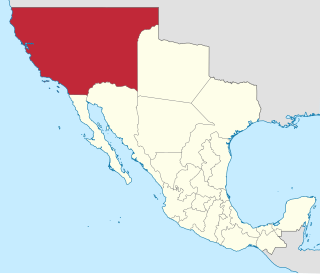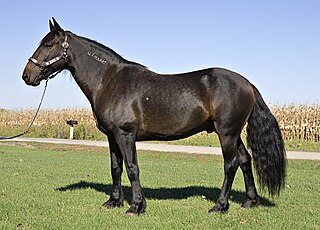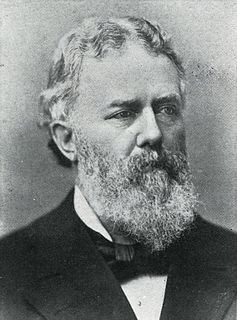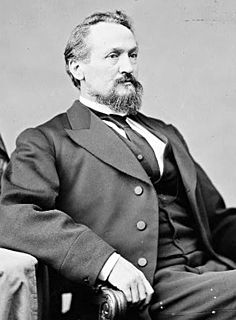Related Research Articles

Alta California, also known as Nueva California, among other names, was a province of New Spain, formally established in 1804. Along with the Baja California peninsula, it had previously comprised the province of Las Californias, but was split off into a separate province in 1804. Following the Mexican War of Independence, it became a territory of Mexico in April 1822 and was renamed Alta California in 1824. The claimed territory included all of the modern U.S. states of California, Nevada, and Utah, and parts of Arizona, Wyoming, Colorado, and New Mexico. In the 1836 Siete Leyes government reorganization, the two Californias were once again combined. That change was undone in 1846, but rendered moot by the U.S. military occupation of California in the Mexican-American War.

The United Mexican States is a federal republic composed of 32 Federal Entities: 31 states and Mexico City as a federal district. According to the Constitution of 1917, the states of the federation are free and sovereign in all matters concerning their internal affairs. Each state has its own congress and constitution.

A cowboy is an animal herder who tends cattle on ranches in North America, traditionally on horseback, and often performs a multitude of other ranch-related tasks. The historic American cowboy of the late 19th century arose from the vaquero traditions of northern Mexico and became a figure of special significance and legend. A subtype, called a wrangler, specifically tends the horses used to work cattle. In addition to ranch work, some cowboys work for or participate in rodeos. Cowgirls, first defined as such in the late 19th century, had a less-well documented historical role, but in the modern world work at identical tasks and have obtained considerable respect for their achievements. Cattle handlers in many other parts of the world, particularly South America and Australia, perform work similar to the cowboy.

The vaquero is a horse-mounted livestock herder of a tradition that originated on the Iberian Peninsula and extensively developed in Mexico from a methodology brought to Latin America from Spain. The vaquero became the foundation for the North American cowboy. The vaqueros of the Americas were the horsemen and cattle herders of New Spain, who first came to California with the Jesuit priest Eusebio Kino in 1687, and later with expeditions in 1769 and the Juan Bautista de Anza expedition in 1774. They were the first cowboys in the region.

William Learned Marcy was an American lawyer, politician, and judge who served as U.S. Senator, Governor of New York, U.S. Secretary of War and U.S. Secretary of State. In the latter office, he negotiated the Gadsden Purchase, the last major acquisition of land in the continental United States.

The mustang is a free-roaming horse of the Western United States, descended from horses brought to the Americas by the Spanish. Mustangs are often referred to as wild horses, but because they are descended from once-domesticated animals, they are actually feral horses. The original mustangs were Colonial Spanish horses, but many other breeds and types of horses contributed to the modern mustang, now resulting in varying phenotypes. Some free-roaming horses are relatively unchanged from the original Spanish stock, most strongly represented in the most isolated populations.

Californios are Hispanic people native to the U.S. state of California. California's Spanish-speaking community has resided there since 1683 and is made up of varying Criollo Spaniard, Mestizo, and Indigenous Californian origins. Alongside the Tejanos of Texas and Neomexicanos of New Mexico and Colorado, Californios are part of the larger Chicano/Mexican-American/Hispano community of the United States, which has inhabited the American Southwest and the West Coast since the 16th century.

Olga María del Carmen Sánchez Cordero Dávila is a Mexican politician and former jurist. She is the Secretary of the Interior of Mexico, and the first woman to ever hold this position. She previously served as a judge on the Supreme Court of Justice of the Nation, Mexico's highest federal court, from 26 January 1995 to 30 November 2015.

Matthew Paul Deady was a politician and jurist in the Oregon Territory and the state of Oregon of the United States. He served on the Oregon Supreme Court from 1853 to 1859, at which time he was appointed to the newly created federal court of the state. He served as a United States District Judge of the United States District Court for the District of Oregon in Portland, as the sole Judge until his death in 1893. While on the court he presided over the trial that led to the United States Supreme Court decision of Pennoyer v. Neff concerning personal jurisdiction.

Peter Hardeman Burnett was an American politician and the first elected governor of California, serving from December 20, 1849, to January 9, 1851, and the first to resign from office. Burnett was elected governor almost one year before California's admission to the United States as the 31st state in September 1850, and was the last governor during the interim period that began with US military occupation during the Mexican–American War.

Oregon pioneer history (1806–1890) is the period in the history of Oregon Country and Oregon Territory, in the present day state of Oregon and Northwestern United States.

Selucius Garfielde was an American lawyer and politician who was a Delegate to the United States House of Representatives from the Territory of Washington for two terms, serving from 1869 to 1873.
Rancho San Jose was a 22,340-acre (90.4 km2) Mexican land grant in northeastern Los Angeles County given in 1837 by Governor Juan Bautista Alvarado to Ygnacio Palomares and Ricardo Vejar. Today, the communities of Pomona, LaVerne, San Dimas, Diamond Bar, Azusa, Covina, Walnut, Glendora, and Claremont are located in whole or part on land that was once part of the Rancho San Jose.

The Federal Constitution of the United Mexican States of 1857 often called simply the Constitution of 1857 is the liberal constitution drafted by 1857 Constituent Congress of Mexico during the presidency of Ignacio Comonfort. It was ratified on February 5, 1857, establishing individual rights such as freedom of speech; freedom of conscience; freedom of the press; freedom of assembly; and the right to bear arms. It also reaffirmed the abolition of slavery, eliminated debtor prison, and eliminated all forms of cruel and unusual punishment, including the death penalty. It was designed to guarantee a weak central government through federalism, created a strong legislature and an independent judiciary, and a weak executive in order to prevent dictatorship. Liberal ideology of the centrality of private property and suspicion of ownership of property, that is, indigenous communities and the Catholic Church saw the Ley Lerdo incorporated into the constitution.

A ranch is an area of land, including various structures, given primarily to the practice of ranching, the practice of raising grazing livestock such as cattle and sheep most often applies to livestock-raising operations in Mexico, the Western United States and Western Canada, though there are ranches in other areas. People who own or operate a ranch are called ranchers, cattlemen, or stockgrowers. Ranching is also a method used to raise less common livestock such as horses, elk, American bison or even ostrich, emu, and alpaca.

In the Western United States and Canada, open range is rangeland where cattle roam freely regardless of land ownership. Where there are "open range" laws, those wanting to keep animals off their property must erect a fence to keep animals out; this applies to public roads as well. Land in open range that is designated as part of a "herd district" reverses liabilities, requiring an animal's owner to fence it in or otherwise keep it on the person's own property. Most eastern states and jurisdictions in Canada require owners to fence in or herd their livestock.

William Claude Jones was an American politician, poet, fabulist, and "pursuer of nubile females". Among his accomplishments, he was a member of the Missouri and Arizona Territorial legislatures, United States Attorney for New Mexico Territory, and a member of the Hawaiian privy council.
The law of Mexico is based upon the Constitution of Mexico and follows the civil law tradition.

Vallecito, in San Diego County, California is an oasis of cienegas and salt grass along Vallecito Creek and a former settlement on the edge of the Colorado Desert in the Vallecito Valley. Its Spanish name is translated as "little valley". Vallecito was located at the apex of the gap in the Carrizo Badlands created by Carrizo Creek and its wash in its lower reach, to which Vallecito Creek is a tributary. The springs of Vallecito, like many in the vicinity, are a product of the faults that run along the base of the Peninsular Ranges to the west.
Recogida, a Spanish word meaning "to pick up". It is used to mean to collect things like garbage or mail, pick up people or goods, in agriculture to gather, pick or harvest. In animal husbandry, in Spanish America, recogidas or round-ups, were held to gather up horses,, to divide and allocate them among their owners, similar to the original practice of the rodeo for cattle, which was presided over by the Jueces del Campo. In 1851, this office, its one year term and its duties were established in California law. Among these was:
References
- ↑ Guinn, J.M. (1915). A History of California and an Extended History of Los Angeles and Environs: Also Containing Biographies of Well Known Citizens of the Past and Present. Historic Record Company. p. 246. ISBN 9780598508874 . Retrieved 2016-05-17.
- ↑ California; Garfielde, S.; Snyder, F.A. (1853). Compiled Laws of the State of California: Containing All the Acts of the Legislature of a Public and General Nature, Now in Force, Passed at the Sessions of 1850-51-52-53, to which are Prefixed the Declaration of Independence, the Constitutions of the United States and California, the Treaty of Queretaro, and the Naturalization Laws of the United States. S. Garfielde. p. 866. Retrieved 2016-05-17.
- ↑ Wood, W.H.R. (1857). Digest of the laws of California: containing all laws of a general character which will be in force on the first day of January, 1858 ... prepared under an act of the Legislature of California of the session of 1857. S. D. Valentine and son. p. 509. Retrieved 2016-05-17.
- ↑ California (1886). Penal Code and Statutes. Bancroft-Whitney. p. 599. Retrieved 2016-05-17.
- ↑ California; Henning, W.F. (1905). General laws of California: as amended and in force at the close of the thirty-sixth session of the Legislature, 1905. Bender-Chaquette. p. 604 . Retrieved 2016-05-17.